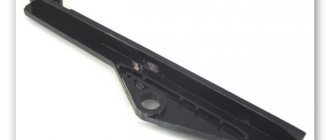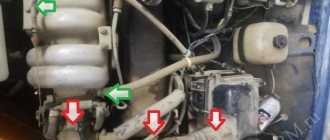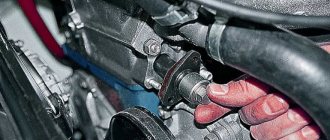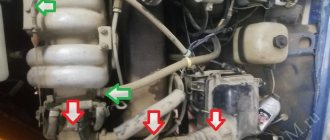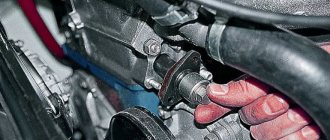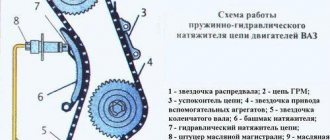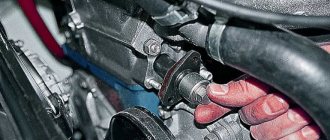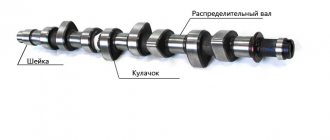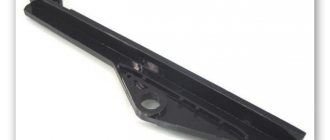Cost of work and parts
The cost of replacing a chain at a service center is around 700 rubles, and the price of complex replacement of a chain, sprockets, tensioner and chain guide is about 1,800 rubles.
The cost of a chain is from 350 to 600 rubles, a set of sprockets (crankshaft sprocket, camshaft and oil pump) is about 400 rubles, a classic tensioner shoe (with a rubber lining) is about 100 rubles, a modernized one with a sprocket on a bearing is about 1,400 rubles, a chain guide is about 80 rubles.
When buying a chain, carefully inspect its rivets ; they should all be well flattened so that not a single pin pops out and the chain does not come apart.
It is recommended to buy a new chain tensioner with a sprocket on a bearing, even despite its high cost. It increases the life of the chain and the noise level with it is much lower than with a classic “shoe”.
In addition, while the engine is running, the rubber pad on the shoe wears off, and all the chips fly into the oil, for this reason the chain needs to be tightened more often. A tensioner with a bearing does not have these problems, and its service life is much longer.
DIY chain replacement
To replace the chain and gears from the car, you will need to drain the coolant and remove the radiator. Loosen the generator and remove the drive belt.
Remove the valve cover and align the marks on the crankshaft and camshaft with the marks on the engine, to do this, align the mark on the crankshaft pulley with the largest mark on the front timing cover.
Having engaged fifth gear and the parking brake, use a 38 key to break off the ratchet (fastening bolt) of the crankshaft pulley.
Remove the crankshaft position sensor (for injection engines) and the front engine cover.
ATTENTION! In addition to the 9 bolts at the top of the cover, there are 3 more that are screwed in from the side of the pallet.
If the car has a carburetor, then the oil pump gear drives the ignition distributor (distributor), and to make work easier, it is recommended to put a mark on the block and on the gear so as not to additionally adjust the ignition.
After removing the cover, bend the locking pins on the oil pump gear (if it needs to be removed) and loosen the locking nuts.
Remove the camshaft gear cotter pin and loosen the nut.
Unscrew the chain tensioner nuts and remove it.
After removing the tensioner, the chain will weaken and it will be possible to easily remove the gears, and behind them the entire chain.
Check the condition of the crankshaft gear, tensioner shoe and chain guide, replace if necessary.
Reassemble everything in reverse order, but with some special features:
- if the oil pump gear is changed on a carburetor engine, put a mark on the new one in the same way as on the old one;
- First, the damper and chain tensioner shoe are installed;
- next is the crankshaft gear, onto which a new chain is thrown;
- the chain is passed from top to bottom, after which it is wound onto the crankshaft gear;
- then the oil pump gear is inserted into the chain and seated on the shaft (for a carburetor engine according to preset marks);
- last of all, the camshaft gear is inserted into the chain and installed on the camshaft;
- when installing the camshaft gear, the marks on the crankshaft and camshaft gears must coincide with the marks on the block and the canister; if this does not happen, you need to rearrange the chain by teeth until they match; A slight deviation is allowed, because on new gears during manufacturing, the marks are not always accurately marked;
- after aligning the marks, install the chain tensioner, first pushing it all the way and fixing it in this position by unscrewing and tightening its lock;
- After installing the chain tensioner, tighten it by releasing the tensioner lock and turning the crankshaft 2 turns, then tighten the lock;
- after the chain is tensioned, use a torque wrench to tighten the camshaft and oil pump gear bolts with a force of 4-5 kgf∙m and bend the tongues of the cotter pins;
- install the front cover with a new gasket and, if necessary, replace the front crankshaft oil seal, install the pulley and tighten its bolt (ratchet) with a force of 10-12 kgf∙m.
Everything else is assembled in reverse order.
Timing chain VAZ 2106: characteristics
| Engine | Number of timing chain links | Chain length |
| VAZ 2101, 05, 011 | 114 | — |
| VAZ 2103-2106 | 116 | 495.4..495.8 mm |
- Remove the air filter housing and cover the carburetor with a rag so that nothing unnecessary gets into it. At the same stage, you can drain the oil from the engine.
- Disconnect the choke cable and the central wire from the distributor.
- Disconnect the tubes and move them to the side so as not to interfere.
- Remove the fan casing.
- If the impeller is on the pump, then unscrew the bolts securing it and remove it along with the generator drive belt and pulley.
- Remove the crankcase protection.
- Clean the entire front part of the engine from dirt, rinse with solvent or gasoline.
- Place chocks under the rear wheels, engage maximum gear (fourth or fifth), and pull out the handbrake.
- To loosen the nut on the ratchet, you need to hit it sharply with a hammer.
- Remove the cover from the block head by unscrewing all the nuts securing it.
- Bend back the washer that is located under the camshaft sprocket bolt. By sharply hitting it with a hammer, loosen the tightening.
- You remove the car from speed.
- Rotate the crankshaft pulley until the mark on the crankshaft pulley with the mark on the front cover moves. At the same time, the mark on the ripening star and the ebb on the pastel should be aligned.
- Unscrew the nut on the ratchet and remove the pulley.
- Unscrew the nuts and bolts that secure the front engine cover. There are 9 attachment points in total. Remove the cover.
- Bend the locking plate and remove the bolt from the accessory drive sprocket.
- Loosen the nut on the VAZ 2106 timing chain tensioner. Using a mounting spatula, press the tensioner and fix it by tightening the nut.
- Unscrew the bolt on the camshaft.
- Unscrew the limit pin near the small crankshaft sprocket.
- Release the chain and remove this sprocket from the crankshaft.
- Taking care not to turn it, remove the auxiliary mechanism drive sprocket and timing chain 2106.
Read more: Replacing glow plugs on a diesel engine
At this point, the removal can be considered complete; now you need to install a new one. But be sure to generously lubricate the chain with fresh engine oil before starting any work.
Marks on the camshaft VAZ 2106
I’ll say even more - it is advisable to replace the timing chain at the same time as changing the oil in the VAZ 2106 engine. In general, the sequence is strictly the opposite:
- Tighten all the bolts that secure the sprockets. Rotate the crankshaft two turns to check whether the marks on the crankshaft and camshaft sprockets are aligned. If everything is installed correctly, then all the marks should match (on the crankshaft sprocket opposite the ebb in the block, and on the distribution sprocket opposite the ebb of the bearing cover).
- All bolts are tightened only with a torque wrench. The tightening torque should be in the range of 41.2-51 N*m.
- Tension the chain.
- Wipe all seats and install gaskets (new).
- Install the generator drive and impeller.
- Check the ignition timing. If necessary, adjust it.
- Loosening and unscrewing two bolts securing the timing chain guide housing 2106.
- Unscrew both tensioner mounting nuts.
- Unscrew the shoe fastener and pull it out (along with the shoe itself).
- Install the damper first.
- On the new tensioner, loosen the cap nut. Press the rod all the way in and tighten the nut. This fixes the rod and puts the tensioner in its place without any problems.
- Knock out the oil seal and use a suitable mandrel to replace it with a new one.
- Unscrew the cap nut and remove it. At the same time, the timing tensioner rod extends and the chain is tensioned by means of a shoe.
- Turn the crankshaft one to one and a half turns. In this case, the spring on the shoe should itself adjust the tension force. Please note that you can turn the crankshaft in three ways: with a ratchet wrench, with a crooked starter, or if you jack up one rear wheel and engage maximum gear. Of course, it is most convenient to do this with a ratchet wrench, since the next step will be problematic to complete yourself.
- Feel the tensioner rod and turn the crankshaft. Stop at the moment when the rod goes to its maximum depth into the body.
- Replace the cap nut and tighten it.
It is worth saying a few words about the correct replacement of the timing chain of the VAZ 2106 and similar models (2101-2107). You should not succumb to provocations and listen to “experts” who advise disconnecting the chain and stretching it, tying it to the old one with wire.
This method has a chance to exist only in one case - if the breakdown overtook you on the road, far from populated areas, and you need to drive a bloody nose for a hundred, five hundred, thousand kilometers in order to carry out high-quality and correct repairs after that.
But if you have all the tools and capabilities, then you shouldn’t do repairs right away that are of poor quality, no matter how. Here, perhaps, we can finish a short excursion into the theory of engines, and specifically into the design of the timing chain drive on the VAZ 2106.
As you can understand, all the work can be easily done with your own hands and quite quickly.
The chain has virtually zero ability to stretch and compress, and fairly limited flexibility. Therefore, in order to provide it with constant tension while working in its place at any speed, it has to be literally shackled, using a system of tensioners and dampers.
This problem on the VAZ 2106/2107 is solved by a damper - an additional spring-loaded clamping bar. They have a steel frame covered with a layer of durable rubber. Tensioners and dampers dampen vibration and noise quite effectively. The chain is prevented from falling off by a stop pin that is screwed into the block or cylinder head. During normal operation the chain does not touch it.
Replacing the timing chain on a VAZ is necessary when its critical wear has occurred, its service life has been exhausted, and tightening it with all sorts of “cunning” methods no longer gives results. These methods include:
- increasing the length of the working part of the tensioner by pressing on a piece of tube of a suitable diameter;
- “addition” of an additional bracket to the shoe and other “bullying” of the engine.
An extended timing chain no longer ensures accurate valve timing, which negatively affects engine performance. In addition, she wears out the shoe and constantly “beats the head off” the pacifier. In addition, engine noise increases, fuel consumption increases and engine starting becomes worse. It is also worth saying that the chain sometimes breaks with all that it entails.
For work we will need: keys “10”, “13”, “17”, a special wrench for the crankshaft pulley nut (or a “36” head), a screwdriver, a mounting blade, a hammer, and a bit.
- Fenox PC2103C3 — 519 rub.
- Kraft KT 017736 — 620 rub.
Read more: AUX cable for car radio and Aux output what you need to know
The original number of the timing chain tensioner is 2101-1006060, the average price is 364 rubles.
- TSN 671 — 254 rub.
- Riginal RG2101-1006060 — 230 rub.
- Trialli MT 151 — 407 rub.
Replacement frequency: every 200 thousand km.
First, remove the block head cover.
Now we turn the crankshaft until the mark on the camshaft sprocket aligns with the mark on the housing.
The mark on the crankshaft will also need to line up with the mark on the camshaft cover.
Next, bend the lock washer of the camshaft sprocket bolt. Then we engage fourth gear and put the car on the handbrake.
Then loosen the camshaft sprocket bolt.
Using a 10mm spanner, unscrew the two nuts of the studs connecting the parts of the casing. Using a 10mm socket with an extension, unscrew the bolt securing the upper casing to the bracket. We remove the casing. Using the “10” wrench, unscrew the “propeller”.
Using a 10mm wrench, unscrew the three nuts and six bolts securing the camshaft drive cover to the cylinder block.
Remove the camshaft drive cover.
Using a 17mm wrench, unscrew the bolt securing the tensioner shoe.
... and remove the shoe.
Using a chisel, bend the edge of the lock washer on the oil pump drive sprocket bolt.
Using a 17mm wrench, unscrew the bolt securing the oil pump drive sprocket.
Remove the bolt and washers.
We remove the star. We take out the camshaft drive chain. Then, lifting the chain, remove the camshaft sprocket.
Using a 10mm wrench, unscrew the chain limiting pin and remove it.
Before installing the chain, align the mark on the crankshaft sprocket with the mark on the cylinder block.
Using a 13mm socket, loosen the cap nut of the chain tensioner. Turn the crankshaft clockwise one and a half to two turns. In this case, the tensioner spring, acting on the tensioner shoe, will automatically adjust the chain tension. Tighten the tensioner cap nut.
As the vehicle is used, the chain drive slowly stretches. Deformation of the metal joints does not occur - the reason for the phenomenon lies in the abrasion of the hinges of each link, the formation of gaps and backlash. Within 1-2 bushings, the wear is small, but multiply the gap by 116 and you will get a noticeable elongation of the element as a whole.
How to determine the malfunction and degree of wear of the chain:
- The first symptom is an extraneous noise coming from under the valve cover. In particularly advanced cases, the sound turns into loud rattling.
- Remove the valve cover and check the alignment of the marks on the camshaft sprocket and crankshaft pulley with the corresponding protrusions on the body. If a shift of 10 mm or more is observed, the element is clearly stretched.
Once, during the process of diagnosing the “six” engine, I had to observe the following picture: the elongated chain not only broke the damper, but also made a deep groove in the cylinder head housing. The defect partially affected the valve cover contact plane, but no cracks or engine oil leaks occurred.
A chain stretched by 1 cm or more can jump 1-4 links along the gears. If the element “jumped” one section, the valve timing is disrupted - the engine vibrates strongly in all operating modes, significantly loses power and often stalls. A clear symptom is shots in the carburetor or exhaust pipe. Attempts to adjust the ignition and adjust the fuel supply are useless - the engine “shaking” does not stop.
- double-row chain, suitable for a specific engine type;
- 3 gears - two large and one small (sold as a set);
- tensioner shoe;
- damper plate;
- power unit front cover gasket;
- high temperature silicone sealant.
Let's start replacing
Bottom line
As a result of replacing the chain, the phases of the gas distribution mechanism return to their limits, engine operation is stabilized and extraneous noise disappears from its front part.
If tensioning the chain does not help, and the noise continues to bother you, do not delay replacing it, because... when beating, it will break adjacent parts and disrupt engine operation.
After purchasing my Kopeyka, I began to slowly repair it and the first thing I did was check the engine, since it rattled terribly. The previous owner said that the valve had burned out, but after removing the valve cover it turned out that the reason was somewhat more serious. This is what I saw after removing the valve covers:
As you can see, the camshaft housing was broken and a piece was lying in the head on top. Moreover, nearby in the same pile lay another rocker with a spring. It is not surprising that the previous owner of the VAZ 2101 thought that the valve had burned out, since the symptoms were similar - one cylinder was not working. Below I will tell you in more detail about the repair of a VAZ 2101-2107 with similar problems.
Replacing the camshaft with a pencil case on a VAZ 2101-2107 with your own hands
So, the first thing I did was go and buy another camshaft from a guy. Of course, I didn’t count on a new one, but as it turned out, it was in vain. This guy took out a camshaft wrapped in paper from the times of the USSR. And along with it he gave away a set of rockers. For this purchase I gave him 750 rubles. Although in the store these new parts cost at least 2,000 rubles.
First of all, we remove the valve cover by unscrewing all its fastening nuts with a 10mm wrench, after which we get this picture:
Now you need to use a flat screwdriver to bend the washer under the camshaft star mounting nut:
And unscrew the nut with a 17mm wrench, as shown in the photo below:
Now unscrew the timing chain tensioner bolt, which is located on the front right side:
Once the chain is loosened, you can gently tap on the inside of the sprocket to make it pop off:
Next, you can begin to unscrew the nuts securing the camshaft cover on the VAZ 2101-2107, as shown in the photo below:
And then you can remove the housing along with the engine camshaft by simply grasping it and pulling upward with a certain force:
The final result of the work can be seen in the picture below:
Now we take new rockers and install them in place of the old ones. This is necessary, since the old ones already have wear and tear and adjusting the valves will be quite problematic, and you may not be able to get rid of the knocking at all. Rockers are quite easy to change. You need to lift it all the way up and it can be removed without problems:
It is also advisable to replace the springs, since they cost pennies, only 3 rubles apiece. New rockers are installed without any sequence. If you install old ones, then they need to be installed in the same order in which they stood.
Then we take the new camshaft assembly 2101-2107 and install it on the cylinder head, after which we tighten the nuts with a torque wrench:
They should be tightened in a strictly defined sequence, as shown in the diagram:
A force of 18 to 21 Nm is required. Do not exceed the specified value range as this may damage the threads. After installation, we put the sprocket and chain back on and be sure to adjust the valves on the VAZ 2101-07
We start the engine and check how everything works, and if necessary, adjust the valves again! I succeeded on the first try and quite successfully, the motor now works as it should.
In addition to the timing chain, we will also replace the tensioner shoe, alternator belt, damper and sprockets. Before you start, prepare your tools; you will need a standard set of keys, as well as a universal pulley lock, a special key for “36”, and an empty container for draining antifreeze.
1. Remove the air filter housing from the carburetor.
2. Unscrew three nuts with a “10” wrench and four more with an “8” wrench.
5. Using a “10” wrench, unscrew the eight nuts securing the valve cover, then remove the washers with the plates.
9. Loosen the generator mounting nut with a “19” key.
10. Loosen the clamps on the pipes and remove them.
11. Next, you need to loosen the clamp on the lower pipe of the water pump and remove it.
12. Turn off power to the fan and temperature sensor on the radiator.
14. Loosen the generator tensioner nut, then use a pry bar to slide it forward.
15. Remove the VAZ 2106 generator belt.
17. Unscrew the “36” nut that secures the crankshaft pulley. Lock the pulley using a special key and unscrew it. If you do not have a special key, engage fifth gear, press the brake pedal, then use the key to unscrew it.
20. Unscrewed the bolt securing the camshaft sprocket and removed it. Mark or try to remember the alignment position. After that I saw the following picture.
- A fuse that prevents the circuit from jumping.
- Fastening the timing chain tensioner shoe.
- Crankshaft sprocket.
26. Place the chain tensioner in place, then activate it. Tighten all mounting bolts and “lock” them. After turning the crankshaft two turns, make sure that the marks match and the valves do not meet the pistons.
28. Place the pulley, check again that the marks match and tighten it.
30. Install the distributor in place, and do not forget to turn on the ignition after completing the procedure for replacing the VAZ 2106 timing chain.
Actually, that’s it, replacing the timing chain on a VAZ 2106 with your own hands is completed, I hope it’s successful!? Thank you for stopping by, all the best, see you again at VAZ DIY Repair!
How to set the ignition on a VAZ 2106? (Step by step video instructions)
The main reason for replacing a double row timing chain is excessive stretching.
The critical elongation is detected remotely by noise - the chain rattles and rubs against adjacent parts. In fact, extreme wear leads to loss of power, throttle response and unstable engine operation due to the mutual displacement of the camshaft and crankshaft. This will be visually indicated by a displaced auxiliary drive pulley. Coordination of the relative position angles of the camshaft (CV) and crankshaft (CV) is done by aligning the marks on the sprockets with the ebbs on the engine housings. There are two of the latter: one is located on the front aluminum cover (long dash), the second is on the bed of the RV. Unambiguity of the relative location of the “beacons” is important throughout the entire chain change operation.
Welcome!
Do you know what valve timing is? In the article we will get acquainted with the concept and try to explain and show clearly the correct installation of phases by marks.
Note! You will need the following tools: a screwdriver, three wrenches “8”, “10” and “13”, a special wrench for turning the crankshaft pulley (if you don’t have one, use a “36” socket).
While operating a VAZ 2106 car, the car owner may encounter difficulty starting the engine and interruptions in the operation of the power unit. The cause of such malfunctions is incorrectly set ignition timing, which requires timely adjustment. This kind of work is not particularly difficult, so even those car owners who have little idea about repairing their car can handle it. In this article we will tell you how to set the ignition on a VAZ 2106.
The car is accelerated to a speed of approximately 45 kilometers. They turn on fourth speed and sharply press the gas pedal. After such a sharp acceleration, pronounced detonation and ringing of the so-called fingers appear, which goes away as the car accelerates, this may indicate a faulty ignition.
Carrying out such engine repairs yourself is not difficult. To set the ignition of the VAZ 2106 yourself, you will need the following tools:
- Voltmeter or test light operating on 12 volts.
- Socket wrench No. 13.
- Candle key.
You can set the ignition on the VAZ 2106 engine to 4 or 1 cylinder. The operating algorithm is slightly different depending on the cylinder with which the work is being done. Also in this article we will tell you how to set the electronic ignition on a VAZ 2106. First of all, you need to determine which marks will be used to set the ignition.
The ignition is set according to the marks on the timing belt. The long mark corresponds to zero ignition, the middle mark corresponds to five degrees of the angle, the short mark corresponds to ten degrees of the advance angle. You can also find the top dead center mark on the pulley rim, and there is also a small indentation on the pulley located opposite the top dead center mark.
It is according to these marks that you should set the contactless ignition on the VAZ 2106. You need to unscrew the spark plug from the 1st cylinder with a spark plug wrench, close the spark plug hole that appears with a plug or your finger. You need to turn the crankshaft with a special key before the start of the compression stroke. This compression stroke begins as soon as the piston begins to move upward.
Compression can be determined by the pressure in the spark plug hole. You need to turn the crankshaft until the mark on the cover located on the timing belt matches. If you use low-octane fuel, then you need to align the mark on the crankshaft pulley with the long mark, which equals zero advance angle.
If you fill the engine with 92 gasoline, then you need to align the mark with the average mark. Next, unfasten the latches and remove the distributor cover. After turning the crankshaft, the rotor will be in a position where the rotor contact in the distributor is directed towards the first cylinder. Having aligned the marks, you should draw from distributor line that passes through the cover latches and is directed parallel to the engine axis.
In the event that such an imaginary line does not intersect the cover latches, it is imperative to make the appropriate adjustment: Unscrew the nut that secures the distributor, and then pull the distributor up. When rotating the rotor axis, it should be aligned parallel to the engine axis.
We install the distributor in place, fix it with the fastening nut, but do not fully tighten it. Next, you will need a test lamp or voltmeter. This device must be connected at one end to the output of the ignition coil, while the second wire from the lamp is connected to ground or to the carburetor.
Turn on the ignition and smoothly turn the distributor. It is necessary to turn until the control lamp goes out. If the lamp does not initially light, then no adjustment is required. After this, we begin to turn the distributor counterclockwise. As soon as the warning light comes on, secure the distributor by tightening the nut.
We turn on the ignition and install the distributor in place. Checking the correctness of the work done is not difficult. We accelerate the car to a speed of 40 kilometers and sharply press the gas in fourth gear. If such manipulations cause detonation that does not go away when the car accelerates, early ignition is set.
Conclusion
As you can see, self-adjustment and setting of the ignition on a VAZ 2106 car is not particularly difficult. Every car owner can handle this kind of work; you don’t need to use any special tools to set the ignition in your car correctly. If you have any difficulties with this work, then below we have prepared a video that clearly explains how to set the ignition on a VAZ 2106. It is recommended to carry out such an adjustment every 15 thousand kilometers or as characteristic signs of an ignition problem appear.
Read more: How to make LED eyelashes for headlights and plastic eyelashes with your own hands, instructions and video
Content
[ To uncover]
[Hide]
Motorists have long been convinced of the advantages of electronic (non-contact) ignition, which does not have the disadvantages of contact ignition, for example, there is no need to adjust the gap in the contact group. In this article we will look at how to adjust the ignition on a VAZ 2106 for the 1st cylinder.
There are marks and castings on the cylinder head cover and crankshaft pulley.
Using the marks you can adjust the ignition timing:
- the first mark, located clockwise, means that the ignition timing is 10°;
- the middle mark is designed to set the lead angle to 5°;
- the shortest, last mark sets the advance angle to 0°: in this case, the mixture will ignite when the piston reaches top dead center.
Marks on the cylinder head cover
The marks are aligned by rotating the crankshaft, either by a ratchet, or by using a special wrench on the nut.
A classic of the genre, VAZ 2106 '97. This is the second time the timing chain has been replaced on this car in a month, since the first time the client brought an “original VAZ” chain produced in a nearby basement. A month later it stretched and hello again. But we have all been praising the quality of our spare parts for a long time, so we had to consult with experts in the car market and choose the chain that received the least number of complaints. Operation will show!
Along the way, we’ll change the air filter, alternator belt, tensioner shoe, damper and all the sprockets, and the song begins.
The client went on foot to get the non-weight bearing, damper and belt because he did not immediately take care of the purchase.
Let's start replacing
We will need: a special wrench for 36 and a universal pulley clamp.
This car is carburetor, but if an injector is installed, the replacement procedure is not much different.
View under the hood.
Remove the air filter housing from the carburetor. Unscrew the three 10mm and four 8mm nuts securing the housing to the carburetor.
Be careful not to drop anything into the carburetor, otherwise you will have to remove it, and maybe the intake manifold too. Because if, with the car running, they get under the intake valve, then you can go straight to repair the head.
Remove the fuel line and distributor cap. Unscrew the eight nuts 10 securing the valve cover and remove the washers with the plates.
Remove the choke cable and throttle valve drive. Then remove the valve cover along with the gasket; it is also better to replace it.
Remove the protection from below.
Drain the antifreeze.
Loosen the nut 19 securing the generator.
Unscrew the clamps on the pipes and remove the latter.
Loosen the clamp on the lower pipe of the pump and remove it with a slight movement of your hand.
Disconnect the power wires for the cooling fan and the temperature sensor on the radiator. We remove the radiator along with the pipes and thermostat.
Loosen the generator tensioner nut and use a pry bar to move it forward. Remove the generator belt.
Now we rotate the crankshaft by the pulley with a magic wrench of 36 and ensure that the marks on the pulley and the cover match, as well as on the camshaft sprocket and the ebb of the latter bed.
Now comes the fun part. Unscrew the nut 36 holding the crankshaft pulley. We lock the pulley with a special key and unscrew it. If there is no such thing, you can turn on the fifth speed, ask a friend to press the brake and lightly turn the key to unscrew it.
We remove the pulley. We unscrew the six bolts and three nuts 10 on the side, three bolts from the bottom of the camshaft drive cover. Let's take the last one.

